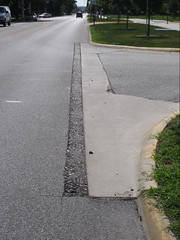Quick Errand
My wife needed something from the drug store, and I needed an excuse for a quick ride that didn't involve going to my office, so I was Walgreens bound.
 On the way, I took my normal work commute and passed this recent road work area. I don't understand why this is done. Whenever, a new road or driveway meets the existing pavement, they cut a piece of the road out, and then have the new road come in to meet it. This ends up putting a seam in the middle of the bike lane (or bike area in this case). I hate seams. Are there any Civil Engineers reading that can explain this?
On the way, I took my normal work commute and passed this recent road work area. I don't understand why this is done. Whenever, a new road or driveway meets the existing pavement, they cut a piece of the road out, and then have the new road come in to meet it. This ends up putting a seam in the middle of the bike lane (or bike area in this case). I hate seams. Are there any Civil Engineers reading that can explain this?
Of course, in this case they apparently cut in too far, and the new road couldn't make it all the way in. Instead, they did a quickie patch job to fill the hole. Nice!
Miles Ridden: 11.7
 On the way, I took my normal work commute and passed this recent road work area. I don't understand why this is done. Whenever, a new road or driveway meets the existing pavement, they cut a piece of the road out, and then have the new road come in to meet it. This ends up putting a seam in the middle of the bike lane (or bike area in this case). I hate seams. Are there any Civil Engineers reading that can explain this?
On the way, I took my normal work commute and passed this recent road work area. I don't understand why this is done. Whenever, a new road or driveway meets the existing pavement, they cut a piece of the road out, and then have the new road come in to meet it. This ends up putting a seam in the middle of the bike lane (or bike area in this case). I hate seams. Are there any Civil Engineers reading that can explain this?Of course, in this case they apparently cut in too far, and the new road couldn't make it all the way in. Instead, they did a quickie patch job to fill the hole. Nice!
Miles Ridden: 11.7



2 Comments:
Wow, what a disaster. It looks like they poured in some concrete for some reason, and also patched a strip of the road. I have no idea why they would do this.
I would speculate that perhaps in order to make a good connection, they have to cut into part of the existing road to get a clean edge. But the photo you posted just looks like shoddy work to me.
Then again, I'm no civil engineer ...
It must be something they teach thee guys in class, because they do the same thing out here. This sort of behavior has always perplexed me. It resembles exorbitant effort for such loathsome results.
Post a Comment
<< Home